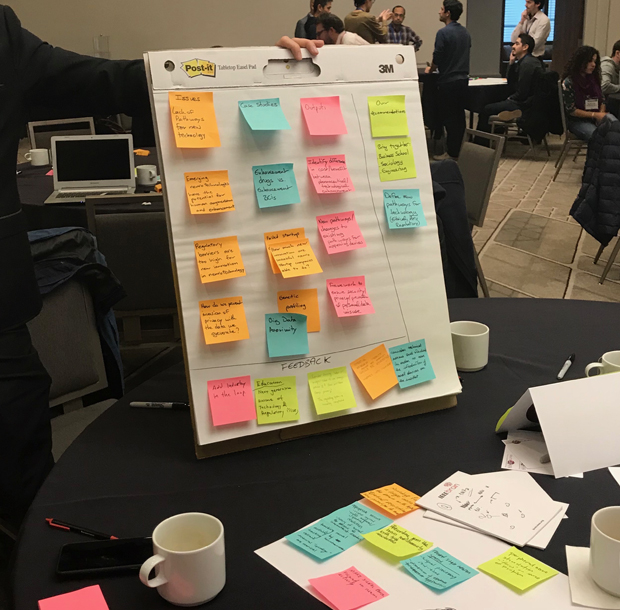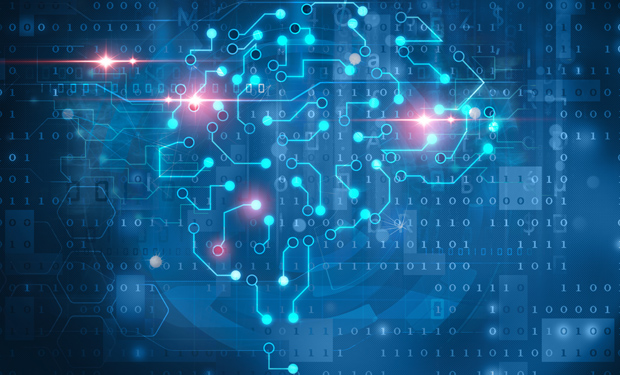The second NeuroCAS event held 20–21 October 2018 in Cleveland, OH, USA, was attended by researchers and entrepreneurs across the fields of biosignals and neurotechnology. On the heels of the IEEE BioCAS Conference, the intent of this collaborative workshop was to offer an opportunity for those within the larger biomedical circuits and systems community interested in brain activity and neurotechnology to interact, hear perspectives outside of their community, and most importantly, discuss current challenges as well as new opportunities across the fields of electrocorticography (ECoG) and brain–body axis (PNS/ANS) interfaces.
The workshop was fueled by a series of brief invited talks, with each speaker not only sharing expertise but also modeling scenarios of opportunities and challenges in different research and entrepreneurial spaces. In addition, participants were asked to note challenges they have encountered in their own work in the hopes that the event would lead to the beginnings of collaborative research and solutions through group discussion (pictured below).

Some of the challenges noted were ubiquitous among attendees, for example, acknowledgment that current scientific understanding of how the brain actually works is limited, which means that when designing technology to work with brain systems it is much like positioning the cart before the horse. Add to this the challenges of interacting with and integrating devices within the greater nervous system in effective and reproducible ways. Communication between different expertise groups was also seen as a challenge for designing effective neurotechnology—engineers and clinicians operate in distinct arenas and without collaboration the technology design often misses the true need of the patient or is too complicated for clinician adoption and use.
Other technical challenge areas raised by participants included the need for more robust interfaces; longer-term stability and longevity of devices; increased miniaturization along with less invasive electrodes; and new ways to deal with device encapsulation and power consumption levels. Data access and long-term analysis as well as interpretable algorithms were seen as opportunity areas. In addition, regulatory complexity and lack of funding were viewed by many as hurdles to translation— actually getting neural interfaces out of the lab and to patients for therapeutic or augmentative use. Finally, addressing the ethical implications of neurotechnology use, especially in cases of altering or augmenting mental and cognitive processes, was identified as something the field as a whole needed to address.
Focusing on economics of clinical translation and the value exchange when designing and promoting new technology, Tim Denison, Royal Academy of Engineering Chair in Emerging Technologies at Oxford University and formerly a Technical Fellow at Medtronic PLC and the Vice President of Research and Core Technology for the Restorative Therapies Group, began the presentations. Beyond issues of driving down cost to patients, Denison noted that it’s important to ask if we are solving problems that people really care about. There is a need to prototype and refine new technologies with end-users not only to demonstrate value for the health care system, but also to show how well we are treating patients through long term care and maintenance of devices, he maintained. Prior to such efforts, evaluating and planning for risk, e.g., how technology can go wrong, is paramount.
Fostering new partnership models (e.g., clinician-research teams) and shifting away from an appliance mentality will be key to creating a platform economy for neural devices, according to Denison. By pursuing new design perspectives, forward looking architecture (e.g., research kits), and business research models, the clinical translation space will become more accessible to neuroscience researchers and designers.
Andrew Jackson, Wellcome Trust Senior Research Fellow in the Institute of Neuroscience at Newcastle University, highlighted key challenges surrounding neurostimulation, particularly when attempting to close the loop. These include challenges surrounding recording of brain signals, including electrode encapsulation. However, there is opportunity here for design of new electrodes as well as designing better ways to record from the brain, including engineering the brain to be more receptive by using optogenetics (e.g., work being done through CANDO—an interdisciplinary project to develop a cortical implant for optogenetic neural control of seizures).
The field of neuromodulation is another area of growth opportunity for neuroscience and neurotechnology. Jeffrey Ardell, MD, Founding Director of the UCLA Neurocardiology Research Program of Excellence, discussed the science behind sensing and neuromodulation-based therapies for treatment of heart disease, including vagus nerve stimulation (see also “Neuromodulation Poses Next Step in Treating Heart Disease”). Efforts such as these rely on multidisciplinary teams to contribute expertise to further understanding of the structure function of the nervous system and how best to work within that system to effect signal changes for health and well-being. There are currently unmet clinical needs in this sphere, which provide openings for neurotechnology.
Knowing the entrepreneurial landscape helps to gauge the likelihood of success for new technology, and venture investment in neurotech devices is growing, according to Brian Pepin, former Engineering Lead for Galvani who has recently moved into the entrepreneurial space. If clinical neural interface performance is limited by both surgical cost and neuroscience understanding, incremental changes that focus on user-centered design often are a better place for small startups. These include devices that don’t require surgery to implant, using ultrasound for example, although it’s important to recognize that such devices may be more complicated for clinicians than traditional surgery and need to marketed accordingly. Other areas to explore include digital therapeutics that present lower costs, fast integration, and a simpler regulatory path. There are opportunities here for hybrid systems, new biosensors, and artificial intelligence (AI).
Presenters also highlighted the promises of ECoG. Gerwin Schalk, Deputy Director of the National Center of Adaptive Neurotechnologies, noted that research and clinical opportunity is accelerated by techniques specific to ECoG that take advantage of the information these high-resolution images provide. Currently, ECoG is the only imaging system that offers high spatial resolution, high resolution in time, and provides measurements across large areas of the brain. Joern Rickert, CEO of CorTec, elaborated on his company’s interdisciplinary efforts to create therapeutic and research solutions through brain–computer interfaces (BCIs), including building better electrodes and developing a platform tool for researchers. Challenges in this sphere remain in the area of electrode technology and placement as well as balancing the number of channels with size of cables, for example. Because of the complex and often invasive technology approaches, regulatory hurdles in attaining approvals for use in clinical research also hinder adoption of these new technologies.
Exploring the Possibilities

Looking toward the future of neuroscience, attendees voiced the need for education to embrace multidisciplinary approaches in order to prepare young researchers for the breadth of this work, and emphasized that collaboration and sharing of research among different stakeholders was vital. Participants also noted that in general, the public perception of neurotechnology versus drug therapy is a value add, but how to capitalize on that perception while managing media hype is an important consideration. In addition, fundamental differences remain between work done in the academic and research setting to generate knowledge and that of a startup focused on consumer applications. Bringing these different drivers closer together with the brain at the center may help drive mechanisms forward.
Potential neurotechnology solutions and research opportunities raised ranged from the far out (deep brain massage for amyloid build-up) to the more practical (ingestible sensors as pain biomarkers and wireless seizure detection). Opportunities were also noted in areas of interconnection and circuit design (e.g., quantum interconnection) and in software development to further define field potentials, among others (pictured above).
Getting to Work

On day 2, workshop organizers gathered the initial ideas and concerns from attendees and grouped these into categories for further exploration (above). Focus areas included scientific understanding; platforms and system integration; power and energy; body and tissue reaction; plasticity; recordings and stimulation; novel sensors; social BCIs; big data and AI; market translation and funding; and regulation and ethics. Participants were then divided into groups and tasked with distilling the listed topics and identifying a key question or statement that would serve to guide collaborative discussion.
Topical questions that emerged from this effort included: Can power modalities (inductive, capacitive, ultrasound) be combined to meet power requirements or can energy be harvested from the mechanical output of muscles and intestines? What interdisciplinary platform is needed to map adverse body/tissue reactions? How best to go about collecting relevant data in relevant quantities while ensuring privacy and security? Should the brain be allowed to adapt to neural interfaces or vice versa?
For the final portion of the workshop, participants chose a topic of interest from among these categories to collaboratively pursue and develop in small groups, then present to the room as a whole (below). This is where initial ideas were stretched to encompass potential research projects as well as new directions and imperatives for the field as a whole. For example, those interested in sensors discussed new ways to record and stimulate potentially using optical probes as well as deploying microfibers to help limit and remove scarring, and the social BCI team explored augmented social awareness through stimulation of the limbic system.


Market translation drew several participants to examine barriers to entry and clinical inertia, with suggestions ranging from using pharmaceutical developmental models as examples for moving products from the lab to patients. In tandem, the team addressing regulation and ethics noted that lack of regulatory pathways for neurotechnology poses a severe liability for translation. Proposed solutions encompassed educating regulatory bodies and the public more directly on ethical use and therapeutic benefits of neuro devices as well as working with support agencies to lobby for new regulatory procedures.
Those who dove into issues related to neuroscientific understanding proposed the development of a new field to address the paradigm shift taking place: neuroepistemology, which would encompass the broader theory of knowledge required to address the range of subjects and methodologies that fall under the rubric of researching and understanding brain function (below). Such a field would be interdisciplinary and collaborative, allowing for research and publications that extend beyond current boundaries. This pursuit would be in line with calls to develop a neurotechnology roadmap and boost the rise and frequency of neurotechnology fellows.

From dreams to attainable steps, the event pushed attendees to move beyond usual comfort zones and imagine bold new approaches to the challenges surrounding the future of neurotechnology. Efforts such as these that focus on interdisciplinary collaboration help to identify opportunities that offer potential to transform the field. NeuroCAS will take place again in 2020 following the IEEE BioCAS Conference.
Acknowledgements
Workshop organizers for the NeuroCAS 2018 event included Tim Constandinou, Imperial College London, as General Chair; Theme Chairs Aysegul Gunduz, University of Florida, and Matthew Schiefer, Case Western Reserve University; Pedram Mohensi, Case Western Reserve University, and Dustin Tyler, Case Western Reserve University, IEEE BioCAS 2018 Co-Chairs. Additional support for the workshop was contributed by the IEEE Brain Initiative.



